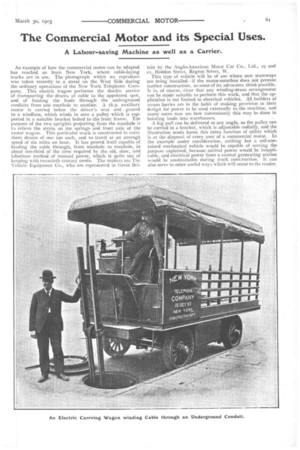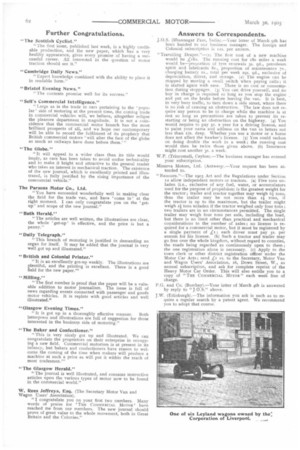The Commercial Motor and its Special Uses.
Page 11

Page 12

If you've noticed an error in this article please click here to report it so we can fix it.
A Labour-saving Machine as well as a Carrier.
An example of how the commercial motor can be adapted has reached us from New York, where cable-laying trucks are in use. The photograph which we reproduce was taken recently in a street on the West Side during the ordinary operations of the New York Telephone Company. This electric wagon performs the double service of transporting the drums of cable to the appointed spot, and of hauling the leads through the underground conduits from one manhole to another. A th.p. auxiliary motor is carried below the driver's seat and • geared to a windlass, which winds in over a pulley which is supported in a suitable bracket bolted to the front frame. The purpose of the two uprights projecting from the manhole is ta relieve the strain on me springs and front axle of the motor wagon. This particular truck is constructed to carry three drums of one ton each, and to travel at an average speed of six miles an hour. It has proved itself capable of hauling the cable through, from manhole to manhole, in about one-third of the time required by the old, slow, and laborious method of manual power, which is quite out of keeping with twentieth century needs. The makers are The Vehicle Equipment Co., who are represented in Great Bri tain by the Anglo-American Motor Car Co., Ltd., to and 21, Heddon Street, Regent Street, W.
This type of vehicle will be of use where new tramways are being installed—if the motor-omnibus does not prevent further construction, as some of its advocates think possible. It is, of course, clear that any winding-drum arrangement can be made suitable to perform this work, and that the application is not limited to electrical vehicles. All builders of steam lorries are in the habit of making prevision in their design for power to be used externally to the machine, and many users now see how conveniently this may be done in hoisting loads into warehouses. A big pull can be delivered at any angle, as the pulley can be carried in a bracket, which is adjustable radially, and the illustration sends home this extra function of utility which is at the disposal of every user of a commercial motor. In the example under consideration, nothing but a self-contained mechanical vehicle would be capable of serving the purpose explained, because animal power would be inapplicable, and electrical power from a central generating station would be unobtainable during track cons:ruction. It can also serve in other useful ways which will occur to the reader.
Further Congratulations.
The Scottish Cyclist."
"The first issue, published last week, is a highly credit• able production, and the new paper, which has a very healthy appearance, gives every promise of having a successful career. All interested in the question of motor traction should see it."
"Cambridge Daily News."
"Expert knowledge combined with the ability to place it in readableform."
"Bristol Evening News."
The contents promise well for its success."
Sell's Commercial intelligence."
" Large as is the trade in cars pertaining to the ` popular ' side of motoring at the present time, the coming trade in commercial vehicles will, we believe, altogether eclipse the pleasure department in magnitude. It is not a coincidence that the commercial motor branch has the most brilliant prospects of all, and we hope our contemporary will be able to record the fulfilment of its prophecy that British commercial motors 'will alter the face of the globe as much as railways have done before them.'" "The Globe."
"It will appeal to a wider class than its title would imply, as tare has been taken to avoid undue technicality and to make it bright and attractive to the general reader who takes an interest in mechanical traction. The existence of the new journal, which is excellently printed and illustrated, is fully justified by the rising importance of the commercial vehicle."
The Parsons Motor Co., Ltd.
"You have succeeded wonderfully well in making clear the field for the trade van, and have 'come in' at the right moment. I can only congratulate you on the 'getup' and scope of the new journal."
"Bath Herald."
"The articles are well written, the illustrations are clear, the whole ' get-up ' is effective, and the price is but a penny."
"Daily Telegraph."
"This branch of motoring is justified in demanding an organ for itself. It may be added that the journal is very well got up and illustrated."
"British and Colonial Printer."
"It is an excellently got-up weekly. The illustrations are plentiful, and the printing is excellent. There is a good field for the new paper."
"Milling."
"The first number is proof that the paper will be a valuable addition to motor journalism. The issue is full of news regarding events connected with passenger and goods motor vehicles. It is replete with good articles and well illustrated."
"Glasgow Evening Times."
"It is got up in a thoroughly effective manner. Both letterpress and illustrations are full of suggestion for those interested in the business side of motoring."
"The Baker and Confectioner."
"This is very nicely got up and illustrated. We can congratulate the proprietors on their enterprise in occupying a new field. Commercial inotorism is at present in its infancy, but bakers and confectioners have reason to wel• come the coming of the time when makers will produce a machine at such a price as will put it within the reach of most tradesmen."
"The Glasgow Herald."
"The journal is well illustrated, and contains instructive articles upon the various types of motor now to be found in the commercial world."
W. Rees Jeffreys, Esq. (The Secretary Motor Van and Wagon Users' Association).
"I congratulate you on your first two numbers. Many words of praise for THE COMMERCIAL MOTOR ' have reached me from our members. The new journal should prove of great value to the whole movement, both in Great Britain and the Colonies."
Answers to Correspondents.
J.O.S. (Bliannagar Pass, India).—Your letter of March -gth has been handed to our business manager. The foreign and Colonial subscription is 123. per annum.
"Travelling Draper."—(1) The first 'cost of a new machine would be L'180. The running cost for 18o miles a week would, be—proportion of tyre renewals 3s. gd., petroleum spirit and lubricants 8s., proportion ot maintenance 7s., charging battery is., total per week rgs. gd., exclusive of depreciation, driver, and storage. (a) The engine can be stopped by moving a small switch when paying calls ; it is started again with ease. There is no cost or consumptionduring stoppages. (3) You can drive yourself, and no boy in charge is required so long as you stop the engine and put on the brake before leaving the van. It is best, in very busy traffic, to turn down a side street, where there is no risk of causing an obstruction. The law does not require' any person to be in charge while the machine is at rest so long as precautions are taken to prevent its restarting or being an obstruction on the highway. (4) You would require to pay 53. a 'year for a driving license, and to paint your name and address on the van in letters not less than sin. deep. Whether you use a motor or a horse does not affect the hawker's license. (5) You could reckon on doing double the work in a week ; the running cost would then be twice those given above. (6) Insurance might cost another 35. a week.
W.P. (Trincomali, Ceylon).—The business manager has entered your subscription.
Minerva Motors, Ltd. (Antwerp:.—Your request has been attended to.
"Runcorn."—The 1903 Act and the Regulations under Section 12 allow independent motors or tractors. (a) Five tons unladen (i.e., exclusive of any fuel, water, or accumulators used for the purpose of propulsion) is the greatest weight for the tractor ; trailer and tractor together may weigh 6& tons, thus the trailer may be not more than if tons, if the tractor is up to the maximum, but the trailer might weigh al tons unladen if the tractor weighed only four tons ; two trailers are in no circumstances permitted. The single trailer may weigh four tons per axle, including the load, but there is no limit other than practical and mechanical considerations to the number of axles ; no license is required for a commercial motor, but it must be registered by a single payment of £1; each driver must pay 53. per annum for his license. (b) Such a tractor and trailer may go free over the whole kingdom, without regard to counties, the roads being regarded as continuously open to them ; the one registration alone is necessary. (c) Apply to the town clerk or other district registration officer under the Motor Car Acts ; send £1 is. to the Secretary, Motor Van and Wagon Users' Association, i6, Down Street, W., as annual subscription, and ask for complete reprint of the Heavy Motor Car Order. This will also entitle you to a copy of "Tax COMMERCIAL MOTOR" each week free of charge.
P.G. and Co. (Bombay).—Your letter of March 4th is answered by reply to " J.O.S." above.
J.W. (Edinburgh).—The information you ask is such as to require a regular search by a patent agent. We recommend you to adopt that course.
























